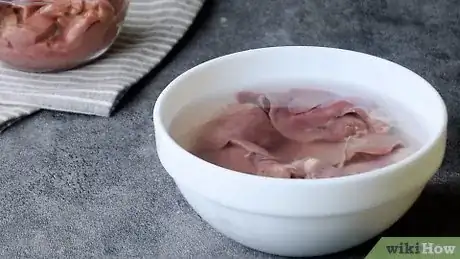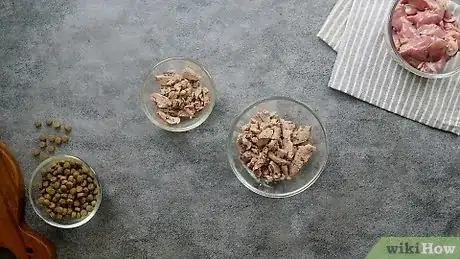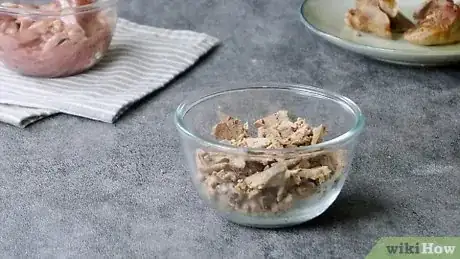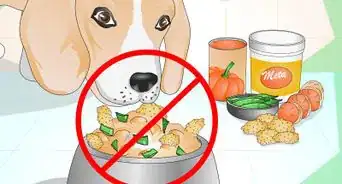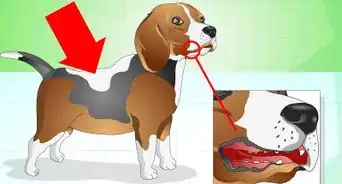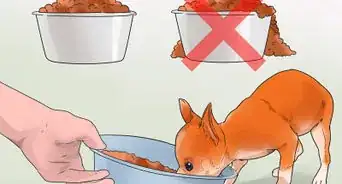This article was co-authored by Beatrice Tavakoli and by wikiHow staff writer, Madeleine Criglow. Beatrice Tavakoli is a Professional Dog Trainer and the Founder/Owner of TAKA Dog Walk in New Jersey. A lifetime dog lover and enthusiast, Beatrice is committed to providing animals with hands-on service dedicated to daily love, adventure, and socialization. As insured and bonded dog walkers, Beatrice, and her staff provide a multitude of services including doggie social hour, day hikes, training, puppy care, canine special events, in-home pet care, boarding, cat care, and customized dog walks.
This article has been viewed 54,346 times.
Interested in cooking a tasty treat for your dog? Chicken livers are a nutritious and scrumptious delicacy for dogs, and they're actually very easy to prepare at home. To learn the best and simplest way to cook chicken livers for your pup, read on. We'll also cover helpful info like serving size and storing instructions so that you have everything you need to know.
Steps
Boiling Chicken Livers
-
1Wash the chicken livers in water. First, remove the chicken livers from the packaging. Then, place them in a bowl and run them under cool water to clean them. After letting the chicken livers soak in water for about 10-15 minutes, drain the water from the bowl and dry each liver with a paper towel.[1]
- If you bought the chicken livers frozen, thaw them in the fridge before proceeding with the cooking process.
-
2Put 1-10 chicken livers in a medium-sized pot. Place the pot on the stove and throw in the freshly cleaned livers. Avoid adding any seasoning like butter or salt. This may upset your pup's stomach, and the livers will be tasty enough on their own.[2]Advertisement
-
3Add water to the pot and bring it to a boil. Pour enough water so that there is about 1 inch (2.5 cm) of water above the chicken livers. Then, wait for the water to come to a boil.[3]
-
4Turn the heat on low and allow the livers to simmer for 10-15 minutes. After the water comes to a boil, immediately turn down the heat. Let the livers simmer uncovered until they are tender (this should take about 10-15 minutes).[4]
- Though 10-15 minutes should be enough time, make sure to cook the chicken livers until they are no longer pink in the middle.
-
5Take the pot off of the stove and drain the water. Once the chicken livers are fully-cooked, drain the pot using a colander. Be sure to use a potholder or oven mitts when you hold the pot to avoid burning your hands.[5]
- If you'd like, save the water as a yummy treat for your dog. Simply drain the remaining water into an ice cube tray and stick it in the freezer.
-
6Place the livers on a plate to cool. Wait until they're warm or room temperature before prepping them to be served.[6]
Serving and Storing
-
1Cut the livers into smaller portions before serving them. This will make the chicken livers easier for your dog to eat and digest. For smaller dogs, dice the chicken livers into tiny, bite-size pieces. For medium to large dogs, cut the chicken livers into slightly larger pieces.[7]
-
2Feed your dog an appropriate serving for their size. Though chicken livers are packed with nutrients, they're also high in fat and vitamin A. To make sure your dog doesn't eat too much chicken liver, feed them a small serving that corresponds to their size. For the most accurate serving suggestion, talk to your veterinarian.
- For an approximate serving size, feed small dogs up to 10–15 grams (0.35–0.53 oz), medium dogs up to 25–30 grams (0.88–1.06 oz), and large dogs up to 40–60 grams (1.4–2.1 oz) of chicken liver 1-2 times a week.[8]
-
3Give your dog chicken liver no more than 1-2 times a week. It's best to think of chicken liver as a yummy snack for special occasions, not a replacement for your pup's usual meals. 1-2 times a week is plenty![9]
- Too much chicken liver can cause your dog to experience Hypervitaminosis A, A.K.A. a vitamin A overdose. Excess vitamin A can also cause muscle weakness, digestive issues, and bone spurs.
-
4Experiment with different serving ideas to see what your dog likes. Try adding chicken liver to your dog's kibble to make it more appetizing (this works well for older dogs who have lost their appetite). You might also try mashing the chicken liver together or sprinkling in some nutritional yeast to make it even tastier.
-
5Refrigerate the remaining livers in an airtight container for up to 2 days. Store whatever chicken livers you don't use after serving your pup. To avoid spoilage, keep them in the fridge for no longer than 2 days or freeze them to increase their longevity.[10]
-
6Freeze the chicken livers in an airtight container for up to 3-4 months. If you cooked a hefty portion, then your best bet is to store the remaining livers in the freezer. Before serving the frozen livers to your dog, remember to thaw them in the fridge and heat them up again on the stove.[11]
Warnings
- If your dog is on a special diet, talk to your veterinarian before serving them chicken livers.⧼thumbs_response⧽
References
- ↑ https://dogdorable.com/how-much-chicken-liver-to-feed-dog/
- ↑ https://petloverguy.com/cook-chicken-liver-dogs-cats/
- ↑ https://dogdorable.com/how-much-chicken-liver-to-feed-dog/
- ↑ https://petloverguy.com/cook-chicken-liver-dogs-cats/
- ↑ https://petloverguy.com/cook-chicken-liver-dogs-cats/
- ↑ https://dogdorable.com/how-much-chicken-liver-to-feed-dog/
- ↑ https://dogdorable.com/how-much-chicken-liver-to-feed-dog/
- ↑ https://pets.thenest.com/can-give-liver-eat-dog-10092.html
- ↑ https://pets.thenest.com/can-give-liver-eat-dog-10092.html
